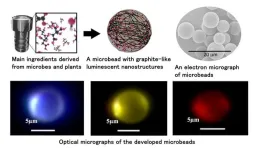(Press-News.org) A recent study from Baylor College of Medicine and Texas Children’s Hospital has identified a specific neural activity pattern as a novel biomarker to accurately predict and monitor the clinical status of individuals with obsessive-compulsive disorder (OCD) who have undergone deep brain stimulation (DBS), a rapidly emerging therapeutic approach for severe psychiatric disorders. The study, led by led by Drs. Sameer Sheth and Wayne Goodman along with co-lead authors, Drs. Nicole Provenza, Sandy Reddy, and Anthony Allam, was published in Nature Medicine.
“Recent advances in surgical neuromodulation have enabled long-term continuous monitoring of brain activity in OCD patients during their everyday lives,” said Dr. Nicole Provenza, an assistant professor at Baylor College of Medicine and McNair Scholar. “We used this novel opportunity to identify key neural signatures that can act as predictors of clinical state in twelve individuals with treatment-resistant OCD who were receiving DBS therapy.”
DBS is emerging as an effective treatment for severe, treatment-resistant OCD
OCD is a common and debilitating mental health condition that affects 2-3% of the population worldwide. About two million people in the US suffer from OCD. In severe cases, patients spend an extraordinary amount of time performing repetitive, seemingly senseless compulsions and perseverating on intrusive thoughts. OCD has a huge toll on the well-being and quality of life of patients and their caregivers and can interfere with the ability to maintain employment and relationships. While psychotherapy and medications are effective in a majority of the affected individuals, approximately 20-40% of individuals with severe OCD are resistant to these conventional treatments.
Since the early 2000s, DBS therapy has been used to modulate neural activity in specific regions of the brain linked to OCD symptoms. Many patients who qualify for this therapy have not received sufficient benefit from conventional therapies. In this treatment-resistant population, roughly two-thirds of patients show significant improvement in OCD symptoms after DBS.
Much like how pacemaker devices regulate electrical activity in the heart, DBS devices regulate electrical activity in the brain. DBS devices carry electrical impulses from the generator, typically implanted in the upper chest, via a pair of thin leads (wires) to specific target regions in the brain. Precise tuning of the stimulation parameters allows the electrical pulses to restore a dysfunctional brain circuit to a healthy state.
DBS is an FDA-approved procedure commonly used to treat movement disorders such as essential tremors and Parkinson’s disease and is increasingly being used to treat severe OCD.
“We have seen remarkable progress in the field of DBS research, a technology that has been used for decades to treat movement disorders,” said Dr. John Ngai, Director of the Brain Research Through Advancing Innovative Neurotechnologies® Initiative (The BRAIN Initiative®) at the National Institutes of Health, which provided partial funding for this study. “The advance reported here represents just one on a growing list of success stories where the BRAIN Initiative has helped develop a new generation of DBS technologies, bringing treatments for conditions like OCD closer to the clinic.”
Need for a clinical biomarker to monitor OCD patient’s response to DBS
Defining the correct dose is oftentimes more difficult for psychiatric disorders like OCD than for movement disorders. “In patients with movement disorders, it is more obvious when stimulation delivery and tuning is correct because abnormal movements such as tremors or stiffness decrease right away,” said Dr. Sheth, professor and Vice Chair of Research in the Department of Neurosurgery at Baylor College of Medicine, director of the Gordon and Mary Cain Pediatric Neurology Research Foundation Laboratories, and investigator at the Jan and Dan Duncan Neurological Research Institute at Texas Children’s Hospital. “However, it is much more difficult to achieve this level of precise DBS programming for OCD and other psychiatric disorders because there is a long delay between stimulation initiation and symptom improvement. It is difficult to know what particular adjustment led to a particular change months later. Our goal in undertaking this study was therefore to find a reliable neural biomarker to guide us during DBS management, and to remotely monitor changes in our patients’ symptoms. This is particularly important because several of our patients travel long distances from around the country or world to get DBS treatment, which for OCD is currently offered only in very few specialized centers.”
Targeting the root of the OCD problem
To identify an optimal target for developing a biomarker, the team focused on one of the most characteristic behaviors in OCD – the tendency for pathological avoidance. Individuals with OCD often suffer from difficult-to-control avoidance of potential harm or distress. In trying to avoid such perceived threats in daily life, they are often plagued by intrusive internal thoughts and irrational fears (obsessions), which lead to rigid routines and repetitive behaviors (compulsions).
The team’s goal was to understand how low-frequency brain oscillations in the theta (4-8 Hz) to alpha (8-12 Hz) range, which have been found by a large body of scientific literature to play a prominent role in cognitive processes, were altered in individuals with severe, treatment-resistant OCD. To do so, they took advantage of a novel feature of modern DBS devices – the ability to not only deliver stimulation but also record brain activity.
Usually, studies that monitor brain activity patterns are designed to be brief episodes that are conducted as participants perform a specific cognitive task. However, this study is unique because the researchers were able to use the DBS system to continuously monitor brain activity patterns in the background of everyday activities. This feature of the study brought the research into the natural lives of the study participants rather than confining it to unnatural laboratory settings.
Recordings started upon implantation of the DBS system. Because stimulation is typically initiated days to weeks later, the team was able to measure neural activity patterns in the severely symptomatic state. Interestingly, they found that 9 Hz (theta-alpha border) ventral striatum neural activity demonstrated a prominent circadian rhythm that fluctuated over the 24-hour cycle.
“Before DBS, we saw an extremely predictable and periodic neural activity pattern in all participants,” said Dr. Goodman, professor and D. C. and Irene Ellwood Chair in Psychiatry in the Menninger Department of Psychiatry and Behavioral Sciences at Baylor College of Medicine. “However, after DBS activation, as individuals began responding and improving symptomatically, we saw a breakdown in this predictable pattern. This is a very interesting phenomenon and we have a theory to explain it. Individuals with OCD have a limited repertoire of responses to any given situation. They often perform the same rituals repeatedly and seldom vary their routines or engage in new activities, which may result in high predictability of activity in this brain region. However, after DBS activation, their behavioral repertoire is expanded; they might respond more flexibly to situations and not be just driven by a strong desire to avoid OCD triggers. This expanded repertoire may be a reflection of the more diverse brain activity pattern. Thus, we think this loss of a highly predictable neural activity indicates that the participants engaged in fewer repetitive and compulsive OCD behaviors.”
“In summary, we have identified a neurophysiological biomarker that can serve as a reliable indicator of improvements in mood and behaviors in OCD patients after DBS treatment. We anticipate these findings to transform how patients are monitored throughout DBS therapy,” added Dr. Sheth, who is also a McNair Scholar and Cullen Foundation Endowed Chair at Baylor College of Medicine.
“Incorporating this information into a clinician-facing dashboard, for example, could help guide therapy delivery, thus demystifying the process of DBS programming for OCD and making the therapy more accessible to a greater number of clinicians and patients. Moreover, we are excited by the potential possibility that such similar neural activity signatures may underlie other neuropsychiatric disorders and could serve as biomarkers to diagnose, predict, and monitor those conditions,” Dr. Provenza concluded.
Other authors involved in the study and their institutional affiliations can be found here. The research reported in this press release was supported by the National Institutes of Health (NIH) BRAIN Initiative under award number UH3NS100549, the McNair Medical Institute at The Robert and Janice McNair Foundation, and the Gordon and Mary Cain Pediatric Neurology Research Foundation and the Jan and Dan Duncan Neurological Research Institute at Texas Children’s Hospital.
END
Researchers discover a new neural biomarker for OCD
2024-07-12
ELSE PRESS RELEASES FROM THIS DATE:
Vivid portrait of interacting galaxies marks Webb’s second anniversary
2024-07-12
Two for two! A duo of interacting galaxies commemorates the second science anniversary of NASA’s James Webb Space Telescope, which takes constant observations, including images and highly detailed data known as spectra. Its operations have led to a “parade” of discoveries by astronomers around the world.
“Since President Biden and Vice President Harris unveiled the first image from the James Webb Space Telescope two years ago, Webb has continued to unlock the mysteries of the universe,” said NASA Administrator Bill Nelson. “With remarkable images from the ...
UMass Amherst awarded $2.1 million to advance the science of engagement in community-academic research partnerships
2024-07-12
University of Massachusetts Amherst researcher Thomas Mackie has received a $2.1 million funding award from the Patient-Centered Outcomes Research Institute (PCORI) to advance the meaningful engagement of communities that are affected by mental health disparities and underrepresented in research partnerships.
The study, entitled “Improving Research Partnership With Engagement Mapping: A Pilot Study to Advance Engagement Science” and co-led by Karen Tabb, a University of Illinois Urbana-Champaign researcher, is designed to empower community partners to have a greater role ...
With gene editing, mice with a form of inherited deafness can hear again
2024-07-12
Researchers have used gene editing to restore hearing in adult mice with a type of inherited hearing loss. They showed that shutting down a damaged copy of a gene called a microRNA (miRNA) enabled the animals to regain hearing. The approach by a research team supported by the National Institutes of Health (NIH), reported in Science Translational Medicine, may eventually lead to potential treatments for inherited hearing loss in people.
Zheng-Yi Chen, DPhil., and his colleagues at Mass Eye and Ear in Boston and other institutions studied a rare form of genetic deafness called autosomal dominant deafness-50 (DFNA50). ...
Sant Pau researchers discover a new gene that causes ALS
2024-07-12
Sant Pau researchers discover a new gene that causes ALS
Researchers from the Neuromuscular Diseases Group and the Dementia Neurobiology Group of the Sant Pau Research Institute (IR Sant Pau) and the Memory Unit of the Sant Pau Hospital, led by neurologist Dr. Ricard Rojas-García, have identified a new mutation in the ARPP21 gene that could be the cause of Amyotrophic Lateral Sclerosis (ALS), a devastating neurodegenerative disease.
Specifically, it is a shared mutation (c.1586C>T; p.Pro529Leu) in the ARPP21 gene that ...
Synthetic biology reveals the secrets of life without oxygen
2024-07-12
Long before photosynthesis brought free oxygen into the world, the earth was already populated by numerous organisms. Oxygen was life-threatening for them and therefore they developed completely different metabolic pathways to those we know from plants, animals and humans. Anaerobic bacteria have survived the ages in special, oxygen-free niches, some of them very close to us: as an essential part of the intestinal microbiome, where they are of enormous importance for the well-being of the organism. However, certain anaerobes can ...
UC3M student startup, Solaris Vita, awarded in Europe's largest entrepreneurship competition
2024-07-12
Solaris Vita, a startup created by students at Universidad Carlos III de Madrid (UC3M), has won second place in the "Innovation of the Year" category at Gen-E 2024, the largest European youth entrepreneurship competition, organized by Junior Achievement Europe. This is the first time that a Spanish university team has won this award.
The promoters of Solaris Vita, Miguel Iglesias (Industrial Engineering graduate from UC3M) and Yann Guichard (Economics student at the University), competed ...
How plant cold specialists can adapt to the environment
2024-07-12
Plant cold specialists like the spoonworts have adapted well to the cold climates of the Ice Ages. As cold and warm periods alternated, they developed a number of species that also resulted in a proliferation of the genome. Evolutionary biologists from the universities of Heidelberg, Nottingham, and Prague studied the influence this genome duplication has on the adaptive potential of plants. The results show that polyploids – species with more than two sets of chromosomes – can have an accumulation of structural mutations with signals for a possible local ...
Biomarkers reveal how patients with glaucoma may respond to treatment
2024-07-12
Markers in the blood that predict whether glaucoma patients are at higher risk of continued loss of vision following conventional treatment have been identified by researchers at UCL and Moorfields Eye Hospital.
Over 700,000 people in the UK have glaucoma and it is the leading cause of irreversible blindness worldwide. The condition occurs when the cells in the eye that help you see (called retinal ganglion cells) start to die.
The main risk factors for glaucoma are high eye pressure and older age.
Currently, all licenced treatments are designed to lower pressure in the eye – also known as intraocular pressure. However, some patients ...
Microbeads with adaptable fluorescent colors from visible light to near-infrared
2024-07-12
1. A research team at NIMS has successfully developed an environmentally friendly, microspherical fluorescent material primarily made from citric acid. These microbeads emit various colors of light depending on the illuminating light and the size of the beads, which suggests a wide range of applications. Furthermore, the use of plant-derived materials allows for low-cost and energy-efficient synthesis.
2. Conventional luminescent devices commonly utilized thin films of compound semiconductors containing metals or sintered inorganic materials with rare earth elements. However, in a circular economy, there ...
Neighborhood disadvantage and prostate tumor RNA expression of stress-related genes
2024-07-12
About The Study: In this cross-sectional study, the expression of several stress-related genes in prostate tumors was higher among men residing in disadvantaged neighborhoods. This study is one of the first to suggest associations of neighborhood disadvantage with prostate tumor RNA expression. Additional research is needed in larger studies to replicate findings and further investigate interrelationships of neighborhood factors, tumor biology, and aggressive prostate cancer to inform interventions to reduce disparities.
Corresponding Author: To contact the corresponding author, ...





